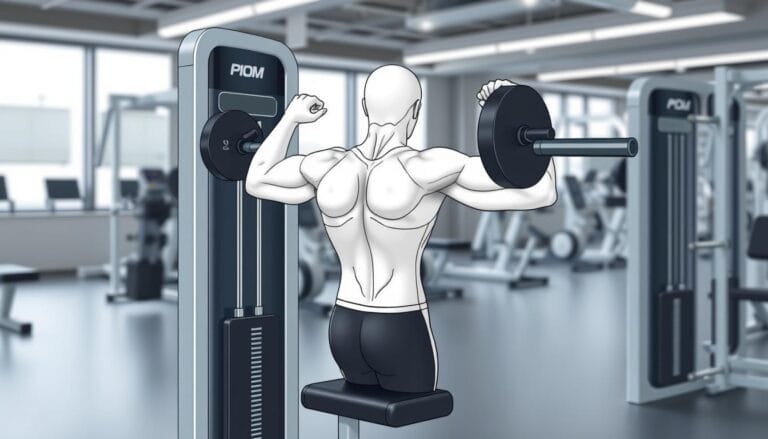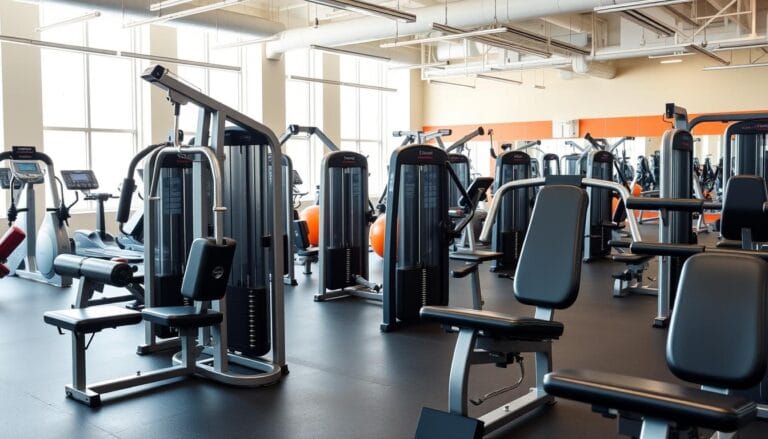How to Perform Shoulder Exercises Using Cable Machines
Every fitness journey has a moment of transformation. For me, that moment came when I discovered cable shoulder exercises. Traditional weightlifting left me frustrated, but cable machines changed everything.
Cable machines offer a new way to train your shoulders. Unlike free weights, they keep constant tension on your deltoids. This ensures maximum muscle activation and growth. Whether you’re experienced or just starting, cable machines can boost your strength and physique.
The deltoid muscles have three heads: anterior (front), lateral (side), and posterior (rear). Each needs specific training for full shoulder strength. Cable machines are great at targeting these areas, helping you create a balanced workout.
Learning the right techniques for cable shoulder exercises can unlock your body’s full potential. This guide will show you how to maximize your shoulder training. You’ll build strength, prevent injuries, and reach your fitness goals.
Get ready to transform your shoulder workouts with cable machines. Your journey to stronger, more defined shoulders begins now.
Table of Contents
Understanding Shoulder Muscle Anatomy and Function
Your shoulder muscles are complex and key for upper body movement. Knowing about your deltoids helps you create better workouts. This is especially true when using gym equipment shoulders and weight lifting machines.
The deltoid muscle is a powerhouse with three distinct parts. Each part has its own role in shoulder exercise equipment and movement:
- Anterior (Front) Deltoid
- Middle (Lateral) Deltoid
- Posterior (Rear) Deltoid
Front (Anterior) Deltoid Function and Movements
Your anterior deltoid is vital for pushing and lifting. It’s at the front of your shoulder. It helps you raise your arm forward and supports exercises like shoulder presses and front raises.
“A strong anterior deltoid is key to powerful pushing movements and overall shoulder stability.”
Middle (Lateral) Deltoid Role in Shoulder Development
The middle deltoid helps with shoulder width and lateral arm movements. When it’s developed, it gives you the V-tapered upper body look many fitness enthusiasts want.
Rear (Posterior) Deltoid and Its Importance
Your posterior deltoid is crucial for pulling movements and keeping good posture. Often overlooked, this muscle group helps balance shoulder strength and prevents injury risks.
By knowing these muscle groups, you can create targeted workouts. These workouts will fully develop your shoulders using cable machines and other specialized shoulder exercise equipment.
Benefits of Using Cable Machines for Shoulder Training
Cable machines are great for shoulder workouts. They offer unique benefits that can change your fitness routine. These machines provide better muscle engagement and controlled movements than free weights.
Cable machines bring several key benefits for shoulder training:
- Constant muscle tension throughout the entire range of motion
- Reduced risk of injury compared to free weights
- Ability to target specific shoulder muscle groups precisely
- Enhanced muscle activation and hypertrophy potential
The overhead press apparatus on cable machines isolates muscles better. Unlike free weights, cables offer consistent resistance. This means your muscles work harder in both moving and returning to the start position. This leads to better muscle growth and endurance.
“Cable machines transform shoulder training by providing unparalleled muscle engagement and control.” – Fitness Performance Research Institute
Cable machines are great for both beginners and advanced athletes. They help correct muscle imbalances by allowing unilateral exercises. You can target the three main deltoid heads – anterior, lateral, and posterior – with great precision.
Adding cable machine exercises to your shoulder training makes workouts safer and more effective. It helps you develop muscles better and reduces injury risks.
Essential Cable Machine Equipment and Setup
Muscle building machinery is key for effective shoulder training. Cable machines offer versatile resistance training devices. They can transform your workout experience. Knowing the right equipment and setup is crucial for muscle growth and injury prevention.
Modern fitness centers have various cable machine options. These machines target different muscle groups precisely. They provide constant tension, which is vital for muscle development.
Types of Cable Attachments for Shoulder Exercises
Choosing the right cable attachments is important for effective shoulder training. Here are the most common attachments:
- Straight bar handles
- Rope attachments
- Single handles
- V-bar grips
- Tricep pushdown bars
Proper Machine Height and Position Adjustments
Proper setup is key for targeting specific shoulder muscles. Adjust the cable machine to align with the specific exercise and your body’s biomechanics.
Key positioning considerations include:
- Align pulley at shoulder height for lateral raises
- Set lower pulley for upward movements
- Adjust upper pulley for overhead pressing exercises
Safety Considerations and Machine Inspection
“Always inspect your equipment before beginning any resistance training routine.” – Fitness Safety Guidelines
Focus on machine safety by checking:
- Cable integrity and smooth movement
- Secure attachment connections
- Proper weight stack alignment
- No visible wear or fraying
By understanding these essential equipment considerations, you’ll optimize your shoulder training and minimize injury risks.
Shoulder Exercises Using Cable: Fundamental Movements
Cable machines are great for shoulder training. They provide constant tension and target muscles well. This is something free weights can’t do.

Knowing the basic cable shoulder movements is key. It helps build strong shoulders. The main exercises are:
- Cable front raise
- Cable lateral raise
- Cable shoulder press
- Reverse cable flyes
“Mastering fundamental movements creates the foundation for advanced shoulder training” – Fitness Experts
Each exercise works on different parts of the deltoids. This ensures your shoulders are fully developed. For example, the cable lateral raise targets the middle deltoid. It helps widen and define your shoulder muscles.
| Exercise | Target Muscle | Recommended Sets/Reps |
|---|---|---|
| Cable Front Raise | Anterior Deltoid | 3 sets of 8-12 reps |
| Cable Lateral Raise | Lateral Deltoid | 3 sets of 10 reps |
| Reverse Cable Fly | Posterior Deltoid | 3 sets of 8-12 reps |
Adding these exercises to your workout routine will give you 3D shoulders. Your muscles will be balanced, and you’ll be less likely to get injured.
Cable Front Deltoid Exercises and Techniques
Strong front deltoids are key for good shoulder strength and sports performance. Cable machines are great for targeting the front deltoids with precision. They offer a consistent tension that helps improve your shoulder workouts.
Cable front deltoid exercises have many benefits for strength training. The constant resistance of cable machines keeps your muscles working hard. This makes your muscles grow stronger than with free weights.
Cable Front Raises
Cable front raises focus on the front deltoid muscle. It’s important to keep the right form and control during the exercise. Here are some key tips:
- Stand facing away from the cable machine
- Grasp the cable attachment with a neutral grip
- Raise your arm straight in front of you to shoulder height
- Slowly return to the starting position
Standing Cable Press
The standing cable press is a great exercise for shoulder strength. It keeps your muscles tense and improves shoulder stability.
| Exercise Variation | Repetitions | Sets |
|---|---|---|
| Strength Training | 6-10 reps | 3 sets |
| Hypertrophy | 8-15 reps | 3 sets |
| Endurance | 12-30 reps | 3 sets |
Cable Upright Rows
Cable upright rows work your front and lateral deltoids well. Make sure to control the motion and avoid using momentum. Keep your core tight and move smoothly.
“Proper technique is more important than lifting heavy weights. Focus on form and muscle engagement.” – Professional Strength Coach
Using these cable machine exercises can help you build stronger, more defined front deltoids. It also reduces the chance of injury.
Targeting Middle Deltoids with Cable Machines
Cable lateral raises are top-notch for building wide shoulders. They target middle deltoids better than free weights. Shoulder workout machines give constant tension, helping muscles grow stronger.

Middle deltoids are key for a V-taper look. Cable machines help you focus on these muscles. This makes your shoulders look wider and more defined.
- Single-arm cable lateral raises provide unilateral muscle engagement
- Dual-arm variations offer symmetrical muscle development
- Constant cable tension maximizes muscle activation
Getting the cable lateral raise right is important. Here are some tips:
- Maintain a slight bend in your elbow
- Control the movement throughout the entire range of motion
- Avoid using momentum to lift the weight
“Precision in movement creates muscle definition” – Strength Training Principle
| Exercise | Sets | Reps | Muscle Focus |
|---|---|---|---|
| Cable Lateral Raise | 3-4 | 8-12 | Middle Deltoids |
| Dual-Arm Cable Lateral Raise | 3 | 10-12 | Symmetrical Shoulder Development |
Pro tip: Adjust the cable machine’s height to create optimal resistance and maximize middle deltoid engagement.
Rear Deltoid Cable Exercise Variations
Working on your rear deltoids is key for strong shoulders and a balanced upper body. Cable machines are great for targeting these muscles well.
The rear deltoids are vital for shoulder stability and good posture. Studies show they make up 50% of external rotation strength. So, it’s important to train them to avoid injuries and keep muscles balanced.
Cable Face Pulls: Precision Rear Delt Training
Cable face pulls are great for building rear deltoids. They:
- Improve shoulder mobility
- Help with posture
- Lower the chance of shoulder injuries
Reverse Cable Flyes: Isolated Rear Delt Activation
The cable reverse fly focuses on rear deltoids. Using the right technique ensures you work the muscles well without straining.
Seated Cable Rear Delt Rows: Targeted Muscle Isolation
Seated cable rear delt rows are perfect for strengthening rear deltoids. They help fix muscle imbalances and make shoulders look symmetrical.
| Training Style | Sets | Reps |
|---|---|---|
| Strength Training | 3-5 | 4-6 |
| Hypertrophy | 3-4 | 8-12 |
| Endurance | 3-4 | 15-20 |
“Consistency is key in rear delt training. Incorporate these exercises twice weekly for optimal results.” – Strength Training Expert
Begin with lighter weights and focus on form. As you get stronger, add more weight. This helps keep muscles growing and lowers injury risk.
Progressive Overload Techniques for Cable Shoulder Training
To grow your shoulders with weight lifting machines, you need a smart plan for progressive overload. This method is key to keep pushing your muscles and growing stronger with your gear.
Progressive overload is the heart of muscle growth. Your muscles get used to things fast, so you must keep making the challenge harder to see real gains.
- Increase weight incrementally
- Adjust repetition ranges
- Modify exercise tempo
- Manipulate rest periods
“The key to muscle growth is never letting your body get too comfortable with your current workout routine.”
For shoulder training with cable machines, you can use several ways to increase the challenge:
| Technique | Implementation | Benefit |
|---|---|---|
| Weight Increment | Add 2-5 pounds every 1-2 weeks | Continuous muscle challenge |
| Rep Range Variation | Shift between 8-12 and 12-15 reps | Muscle confusion and growth |
| Time Under Tension | Slow down movement tempo | Increased muscle engagement |
Always listen to your body and go slow. Start with lighter weights to get your form right before adding more weight. Your shoulder muscles will appreciate the careful, step-by-step approach to getting stronger.
Common Form Mistakes and How to Avoid Them
Proper form is key for effective shoulder training, especially with cable machines. Many people make big mistakes during standing cable shoulder press, cable upright row, and cable shrugs. These errors can hurt their workout results and raise the risk of injury.
- Momentum Misuse: Swinging weights instead of controlled movements reduces muscle engagement
- Incorrect Shoulder Positioning: Improper alignment can lead to strain and reduced exercise effectiveness
- Poor Cable Height Adjustment: Incorrect machine setup prevents optimal muscle activation
“Precision in movement trumps weight lifted every time.” – Strength Training Principle
Here are some tips to fix common form mistakes in cable shoulder exercises:
- Maintain a stable core during standing cable shoulder press
- Keep shoulders down and back during cable upright row
- Control the entire range of motion in cable shrugs
| Exercise | Common Mistake | Correction Technique |
|---|---|---|
| Cable Shoulder Press | Arching Back | Engage Core, Maintain Neutral Spine |
| Cable Upright Row | Elbow Flaring | Keep Elbows Close to Body |
| Cable Shrugs | Using Momentum | Slow, Controlled Vertical Movement |
Remember, perfect form is crucial for muscle engagement and injury prevention. Aim for quality over quantity to get the best shoulder development.
Creating an Effective Cable Shoulder Workout Routine
Creating a good shoulder workout with resistance devices needs careful planning. Your cable shoulder routine should hit all three deltoid heads. This helps grow muscles and avoid imbalances.
When planning your workout at the fitness center, keep these tips in mind:
Workout Structure and Exercise Selection
A good shoulder workout should cover all muscle groups. Your routine might include:
- Front Deltoid Exercises: Cable front raises
- Middle Deltoid Exercises: Cable lateral raises
- Rear Deltoid Exercises: Cable face pulls
Sets, Reps, and Rest Periods
For the best muscle work, follow these tips:
- Sets per exercise: 3 sets
- Repetition range: 8-12 reps
- Rest between sets: 60-90 seconds
“Consistency and proper form are more important than lifting heavy weights.”
Progressive Programming Methods
To keep pushing your muscles, use progressive overload:
- Gradually increase weight
- Adjust rep ranges
- Modify exercise tempo
- Reduce rest periods
Remember, your shoulder muscles account for about 60% of shoulder muscle mass. Working all three deltoid heads helps balance muscle growth and lowers injury risks.
Conclusion
Your journey through shoulder workout machines has shown the power of cable exercises. Cable shoulder exercises target every deltoid region with precision. They offer constant resistance, helping you understand shoulder movements better.
Cable machines are versatile, allowing you to challenge your shoulder muscles from different angles. Exercises like cable front raises and shoulder presses engage muscles in ways free weights can’t. Sticking to proper form and gradually increasing weights will boost your shoulder strength and muscle definition.
Effective shoulder training goes beyond just lifting weights. It’s about understanding muscle mechanics. Cable machine exercises keep tension throughout, maximizing muscle recruitment and reducing injury risk. This way, you’ll build stronger, more resilient shoulders for sports and daily activities.
Keep exploring and improving your cable shoulder exercises as you continue your fitness journey. The knowledge you’ve gained is a solid base for ongoing improvement. Stay focused, maintain proper technique, and trust in progressive overload to enhance your shoulder development.







